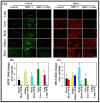SPIKENET: An Evidence-Based Therapy for Long COVID
- PMID: 38932130
- PMCID: PMC11209161
- DOI: 10.3390/v16060838
SPIKENET: An Evidence-Based Therapy for Long COVID
Abstract
The COVID-19 pandemic has been one of the most impactful events in our lifetime, caused by severe acute respiratory syndrome coronavirus-2 (SARS-CoV-2). Multiple SARS-CoV-2 variants were reported globally, and a wide range of symptoms existed. Individuals who contract COVID-19 continue to suffer for a long time, known as long COVID or post-acute sequelae of COVID-19 (PASC). While COVID-19 vaccines were widely deployed, both unvaccinated and vaccinated individuals experienced long-term complications. To date, there are no treatments to eradicate long COVID. We recently conceived a new approach to treat COVID in which a 15-amino-acid synthetic peptide (SPIKENET, SPK) is targeted to the ACE2 receptor binding domain of SARS-CoV-2, which prevents the virus from attaching to the host. We also found that SPK precludes the binding of spike glycoproteins with the receptor carcinoembryonic antigen-related cell adhesion molecule 1 (CEACAM1) of a coronavirus, murine hepatitis virus-1 (MHV-1), and with all SARS-CoV-2 variants. Further, SPK reversed the development of severe inflammation, oxidative stress, tissue edema, and animal death post-MHV-1 infection in mice. SPK also protects against multiple organ damage in acute and long-term post-MHV-1 infection. Our findings collectively suggest a potential therapeutic benefit of SPK for treating COVID-19.
Keywords: COVID-19; SPIKENET; long COVID; molecular mechanism; multiorgan dysfunction; therapy.
Conflict of interest statement
All authors have no conflicts of interest or competing interests to declare.
Figures















References
-
- World Health Organization Who Coronavirus (COVID-19) Dashboard. [(accessed on 10 February 2024)]. Available online: https://covid19.who.int/
-
- Centers for Disease Control and Prevention SARS-CoV-2 Variant Classifications and Definitions. [(accessed on 10 February 2024)]; Available online: https://www.cdc.gov/coronavirus/2019-ncov/variants/variant-classificatio....
-
- Baj J., Karakuła-Juchnowicz H., Teresiński G., Buszewicz G., Ciesielka M., Sitarz R., Forma A., Karakuła K., Flieger W., Portincasa P., et al. COVID-19: Specific and Non-Specific Clinical Manifestations and Symptoms: The Current State of Knowledge. J. Clin. Med. 2020;9:1753. doi: 10.3390/jcm9061753. - DOI - PMC - PubMed
Publication types
MeSH terms
Substances
Grants and funding
LinkOut - more resources
Full Text Sources
Medical
Miscellaneous

